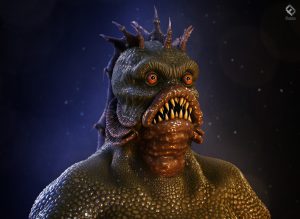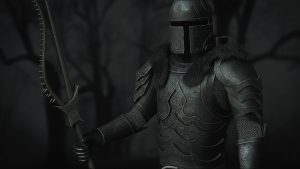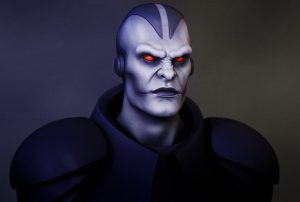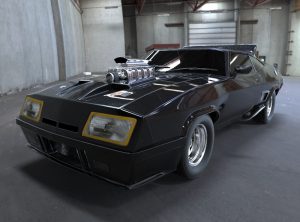
Aesthetics is a Language: Mr. Felipe Juste’s Journey as a Digital Artist
 Varying in style and output, Mr. Felipe Juste is one of great versatility and talent. His works are a combination of the cute, the wild, and the awesome.
Varying in style and output, Mr. Felipe Juste is one of great versatility and talent. His works are a combination of the cute, the wild, and the awesome.
But it was a long road of course and he recognizes that he has a long journey ahead. Mr. Juste has had a lot of experience with various software and thus exhibits wisdom in handling them. He specialized in one after another and brought himself fully into the discipline.
When asked about his software expertise, he said that it is through his numerous experiences in the industry that helped sharpened his sense of Aesthetics and he put it quite beautifully:
I worked for many years in advertisement and design, so Photoshop was my bread and butter alongside Illustrator, Indesign and other software. I worked a few years as a graphic designer until I became an art director and then a photo retoucher. It helped me to develop an aesthetic sense. I had a teacher in the university that used to say that Aesthetics is a language that we need to be fluent in.
Internalizing his experience entirely, he leaves aspirants with a thoughtful message and it couldn’t be any truer:
Art is a slow process, it takes a while for a ball of clay to look like the concept but when it does it is the most rewarding moment.
Mr. Felipe Juste knows what’s going on. He knows what is essential and enriches it further. This is why having him for an interview is such an honor. So let’s sit down and get to know him better and see why Mr. Juste is an artist we should all watch out for.
Xeno Creatives (XC): Needless to say, ZBrush innovated the 3D industry. What was it like using it for the first time? What did you have to learn to be skilled in it?
Felipe Juste (FJ): ZBrush revolutionized the industry, it was such an amazing experience using it for the first time. It was like sculpting in clay but with all the advantages of using a computer. Working with ZBrush, I could say 3D, in general, is a mix of artistic feeling and technical knowledge, so it is interesting to keep both areas in balance while studying.
XC: How does ZBrush help you become more efficient and better at your craft?
 FJ: ZBrush has a very intuitive interface although it doesn’t mean that you don’t have to study the software itself. You might become a good artist using just the basic features but without using all that the software has to offer, you will lose a great deal in performance. It helps you to be more creative without worrying so much about topology, quads, UVs while you are in the creative phase.
FJ: ZBrush has a very intuitive interface although it doesn’t mean that you don’t have to study the software itself. You might become a good artist using just the basic features but without using all that the software has to offer, you will lose a great deal in performance. It helps you to be more creative without worrying so much about topology, quads, UVs while you are in the creative phase.
It gives you freedom to create without limiting your artistic thought, leaving the technical issues for a later stage of the process.
XC: When did you know that you’ll be using ZBrush as your main software to create 3D art in the long run?
FJ: From the very beginning it was clear that if I wanted to model a character my first choice would be ZBrush, leaving other software for hardsurface, props and assets. But it is important to say that software like Maya are still a fundamental part in 3D art.
XC: What were the other media that you explored before ZBrush? Did these ultimately help you in making your creations better while using ZBrush?
FJ: I worked for many years in advertisement and design, so Photoshop was my bread and butter alongside Illustrator, Indesign and other software. I worked a few years as a graphic designer until I became an art director and then a photo retoucher. It helped me to develop an aesthetic sense. I had a teacher in the university that used to say that Aesthetics is a language that we need to be fluent in.
XC: How is the knowledge in human anatomy important when working with ZBrush?
FJ: It is essential if you want to become a character artist. Many people want to use ZBrush to design creatures and believe that they don’t need to study anatomy to create believable characters. It doesn’t matter if your character is human, a humanoid creature, or a beast, it is fundamental to have anatomy knowledge to imagine how this creature would look like. Is jumping its primary way of locomotion? Which muscles would it have developed in order to deliver a fast a lethal blow? There’s more to the Character Design than just claws and wrinkles.
XC: Do you see yourself working in the movie and television industry?
FJ: I just enjoy creating and I don’t really have a preference for movies or games.
XC: Was delving into the craft really a passion to begin with or a mere necessity?
 FJ: It was both. I always had a huge interest in 3D but because of the university and long work hours, I couldn’t focus on 3D for many years, until one day I decided that I should not postpone that anymore, I should pursue what I like to do and I was lucky because it is a much better industry than the one I used to work with in graphics and print.
FJ: It was both. I always had a huge interest in 3D but because of the university and long work hours, I couldn’t focus on 3D for many years, until one day I decided that I should not postpone that anymore, I should pursue what I like to do and I was lucky because it is a much better industry than the one I used to work with in graphics and print.
XC: Your works over at ArtStation show your AMAZING attention to DETAIL. Each concept speaks of a UNIQUE style, thus showing your versatility. But do you have any favorite pieces? What are these and why?
FJ: Thanks! It is very rewarding to see people appreciate your work. I guess my attention to detail comes from my photo retouching background. I have some favorite pieces but I have a notion that it is never good enough. I had a teacher who used to say that you need to be careful not to like your art too much so you can’t see the flaws in it; in my case it is the opposite. Hahaha! Every time I see my models I find something that I could improve. But it is important to let it go sometimes in other to finish a project, begin another one and improve as an artist.
My favorite models are those from which I’ve learned something important while creating them; they have more value to me, like the Black Lagoon Monster, the realistic version of Beedrill, the Cthulhu Knight. But my favorite now is the one I’m working on at the moment. I am learning a lot during the process with the mentorship of my friend and teacher Andre Rossetto—I will post it on ArtStation as soon as I finish it or I might even post as a WIP.
XC: What are the other concepts that you would want to create?
FJ: There are so many of them, I have folders with hundreds of concepts that I would like to model. I’ve been practicing human anatomy a lot or, if not human, at least realistic creatures, so for my next model I would like to try something different like an “Overwatch” kind of style.
XC: Whom do you consider your influences? Why do you look up to them?
FJ: As I mentioned before, Andre Rossetto is an awesome artist. Rafael Souza was also someone whom I lucky to be able to study anatomy with. For 3D they are Rafael Grassetti, Glauco Longhi, Danilo Athayde, Magdalena Dadela, Tim Moreels, Brett Sinclair, Mariem Pepin, Rodrigue Pralier, Igor Catto, Vahid Ahmadi, Pedro Conti, Baj Singh, Ian Spriggs, Dan Roarty, Kris Costa, Vladimir Minguillo, Yekaterina Bourykina, Marlon R. Nunez, Galal Mohey, Madina Chionidi, Yosuke Ishikawa, Bruno Camara, and Gilberto Magno.
 For traditional and FX, Alex Oliver, Rick Fernandes, Norman Cabrera, Jordu Schell, and Rick Baker.
For traditional and FX, Alex Oliver, Rick Fernandes, Norman Cabrera, Jordu Schell, and Rick Baker.
For 2D, Eve Ventrue, Carlos Huante, Gerald Brom, Art Germ, and Kim Jung Gi
There are so many others but it would take forever to name them all!
It is great to see how they became the artists they are now. I once saw a post by Grassetti where he said that he had modeled something like 60 heads for statues and toys. I thought, if he says that he modeled 60 heads that were actually used for that, how many others weren’t approved by clients? How many others did he model for other purposes like games which is his main media? How many others did he model for fun or while studying? That is why he is one of the greatest artists of our generation!
XC: Do you also see yourself in Game Character Design?
FJ: Yes, definitely. But as I said, I love creating things in 3D, so I can apply my skill in any kind of media. As far as games are concerned, there are many technical aspects to consider but it makes quite an interesting pipeline.
XC: If you weren’t a 3D artist today, what do you think you’d be specializing in?
FJ: That is a good question! I have no idea, maybe IT like my mother wanted! Hahaha!
XC: What advice or message can you give young aspirants wanting to enter the craft/industry?
FJ: Study a lot and have patience. Art is a slow process, it takes a while for a ball of clay to look like the concept but when it does it is the most rewarding moment.
Mr. Felipe Juste, we thank you for your time. We are one with your aim of taking your craft further.
Want to see more of Mr. Juste’s works? Click here!

